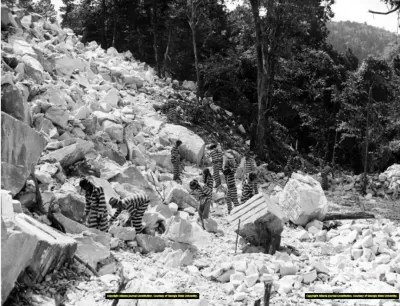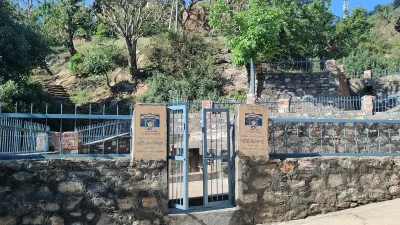Two monuments coming to Atlanta reckon with the city's history of using incarcerated laborers.

The history of Atlanta is set in brick.
It began after the Civil War, when slavery gave way to another form of labor: convict leasing. Black people, many of them children, were arrested for such “crimes” as talking loudly in the company of a white woman or not stepping off the sidewalk when a white person approached. Private companies would then lease these incarcerated people for unpaid labor in inhumane conditions.
“It’s one of those pieces of history that nobody really knows about,” says Donna Stephens, an environmental activist in Atlanta. “There’s so many people that I’ve spoken to that are just in shock about that part of American history. [To them] it’s as if slavery ended and [Martin Luther King Jr.] showed up.”
One of the outfits that profited off convict labor was the Chattahoochee Brick Company in Atlanta. For 30 years, workers there made 200,000 bricks a day—the very bricks that built the city during a formative period. These bricks are throughout downtown and in older buildings and sidewalks, says Douglas A. Blackmon, author of a Pulitzer Prize-winning book on convict leasing. The workers, 30% of whom were children, were whipped, fed rotting food and warehoused in substandard housing. Some were worked to death.
Years later, Atlanta is beginning to reckon with its history of convict labor and the role it has played in not only the city but throughout the South. Plans exist to memorialize the former site of Chattahoochee Brick and at the recently opened Westside Park a few miles away.
Atlanta will be the first city to acknowledge convict labor on a large scale.
FULL STORY: Atlanta Reckons with the Convict Labor that Built the City

Alabama: Trump Terminates Settlements for Black Communities Harmed By Raw Sewage
Trump deemed the landmark civil rights agreement “illegal DEI and environmental justice policy.”

Study: Maui’s Plan to Convert Vacation Rentals to Long-Term Housing Could Cause Nearly $1 Billion Economic Loss
The plan would reduce visitor accommodation by 25% resulting in 1,900 jobs lost.

Planetizen Federal Action Tracker
A weekly monitor of how Trump’s orders and actions are impacting planners and planning in America.

Waymo Gets Permission to Map SF’s Market Street
If allowed to operate on the traffic-restricted street, Waymo’s autonomous taxis would have a leg up over ride-hailing competitors — and counter the city’s efforts to grow bike and pedestrian on the thoroughfare.

Parklet Symposium Highlights the Success of Shared Spaces
Parklets got a boost during the Covid-19 pandemic, when the concept was translated to outdoor dining programs that offered restaurants a lifeline during the shutdown.

Federal Homelessness Agency Places Entire Staff on Leave
The U.S. Interagency Council on Homelessness is the only federal agency dedicated to preventing and ending homelessness.
Urban Design for Planners 1: Software Tools
This six-course series explores essential urban design concepts using open source software and equips planners with the tools they need to participate fully in the urban design process.
Planning for Universal Design
Learn the tools for implementing Universal Design in planning regulations.
Caltrans
Smith Gee Studio
Institute for Housing and Urban Development Studies (IHS)
City of Grandview
Harvard GSD Executive Education
Toledo-Lucas County Plan Commissions
Salt Lake City
NYU Wagner Graduate School of Public Service





























